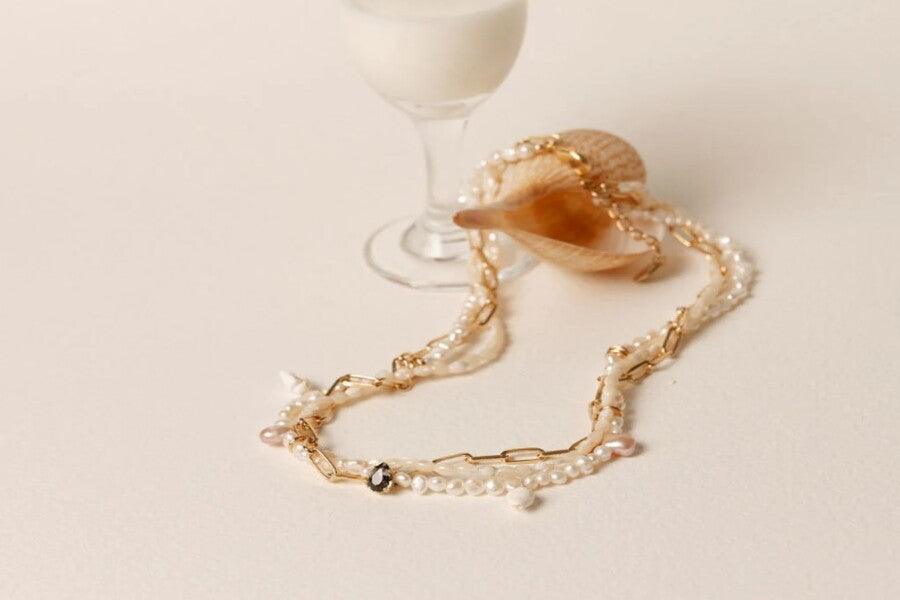Key Takeaways
- Want to learn how to clean cultured pearls ? Want to discover the right ways to care for the pearls in your favorite piece of jewelry? This article will teach you everything!
- If you want your pearls to last for years, it's important that you know how to store them properly. Check out 4 valuable tips below.
Caring for Cultured Pearls
Cultured pearls are distinguished from other gemstones by their organic origin, resulting from a natural process initiated by a mollusk. They are softer and more sensitive and can therefore more easily be scratched, cracked, dried out and thus damaged.
Therefore, caring for cultured pearls carefully, meticulously and correctly is necessary to maintain their beauty for years.
Why You Should Clean Pearls
Every time you wear your pearls, they come into contact with your skin. However, their shine can quickly be tarnished by the little inconveniences of everyday life: sebum, sweat, creams and even perfumes invite themselves to the party. Over time, these intruders risk dulling their sparkling surface.
Not to mention the ambient pollution which also blurs their shine. A good cleaning of cultured pearls is therefore essential to restore their natural shine and protect them from this accumulation of unwanted particles.

Cleaning cultured pearls is a way to preserve the value of the pearls
in the long term
In addition to being pretty little jewels that enhance your outfits, cultured pearls are also a real investment. Whether their value is sentimental or hard cash, it is crucial to pamper them so that they continue to shine as much in your heart as in your wallet.
So, cleaning them regularly is not just to make them prettier, it is also to preserve this precious treasure in the long term.
How to Clean Cultured Pearls?
Cleaning cultured pearls doesn't take hours, but you have to be gentle to preserve their precious nacre layer. Removing dust and dirt will restore your pearls' natural shine. And it's also a great time to check that your necklace, bracelet, or earrings are still in perfect condition.
Step 1 – Check Your Jewelry
Take a few minutes to make sure your precious jewelry is in good condition. Pearls are usually strung on a silk thread with knots between each gem, so as not to lose everything if the thread breaks. Take a look to see if the thread has not become too loose between the pearls. Also pay attention to the clasp of your necklace, it must open and close without any problem. And, yes, it too deserves a little bath in warm soapy water! Ideally, have your pearls examined once a year by a jeweler.

Make sure your precious jewelry is in good condition and prepare a small bath of warm water
to clean them.
Step 2 - Wipe Your Pearls
Gently clean your pearls with a soft piece of white cotton cloth dampened in warm water. Don't be tempted to submerge the necklace or bracelet in water, as this can cause the silk thread to stretch and weaken. If this doesn't do the trick, add a little soap. As you gently wipe each pearl, you may be surprised at how much dirt comes off!

Gently wipe the pearl and absolutely do not immerse it in water!
Once you have cleaned all the pearls with the soapy water, it is time to gently wipe them a second time with a damp piece of white cotton. It is important to do this carefully to ensure that you have removed all the soap. Otherwise, the pearls may lose their shine.
Step 3 – Dry Your Pearls
Finally, gently dry each pearl with a soft piece of white cotton. At this point, they should be sparkling! Close the clasp and place the necklace (or bracelet) on a soft towel until completely dry. Make a habit of always closing the clasp to prevent it from accidentally scratching the pearls. Letting them dry naturally will allow the silk thread to regain its elasticity.

Dry your pearl necklace gently to avoid scratching it!
How to Protect Your Pearl Jewelry?
Some people swear by wearing pearls with impeccable clothing – and for good reason: a pearl necklace only looks elegant after spritzing on that final touch of perfume.
But be careful, never let your pearls come near household products, chemical substances (chlorine, among others), heady perfumes, overly enthusiastic deodorants, acids or excessive heat, at the risk of seeing your precious pearls lose their shine. They are more sensitive than they look!

Definitely keep your pearl necklace away from chemicals, cosmetics and especially perfumes!
Also, given the complexity of their assembly, a word of advice: keep them away from water. In the long term, regular contact with water could cause insidious degradation, going so far as to unstick a pearl from your favorite earrings or leave an unsightly white veil on the shimmering surface of the mother-of-pearl.
How to Store Your Pearls?
As a general rule, your pearl jewelry should be the last touch to your outfit before you go out, and the first thing you take off when you get home. But how do you store it when it's not being worn? We've put together a quick list of the essential things you need to know about storing pearl jewelry.
Always clean before storing
Pearls are alkaline. This means that products like household cleaners, perfume, hairspray, and even self-tanner can eat away at their surface, causing damage and dulling their shine.

As pearls are sensitive to chemicals, clean them after each use.
to preserve their shine.
Use a damp, non-abrasive cloth (such as a pure cotton towel, unbleached natural silk, or microfiber) to remove any traces of chemicals or perspiration. Do this after each use of your pearl jewelry.
Always store your pearls separately to protect them
Never store your pearl jewelry with other pieces. It is especially crucial to keep them away from diamonds and metals, as these can easily scratch the delicate surface of your pearls. Instead, opt for a compartmentalized storage solution that will keep your pearls well separated from other gemstones.
This is why Gisel B offers you these pretty, soft jewelry boxes. Find them here.

Always store your pearls separately from other jewelry, in a compartmentalized space to avoid scratches.
Avoid plastic, it's not for pearls!
Pearls need to breathe. If you put them in a plastic box or airtight bag, they may turn yellow and crack like an old eggshell.
This is why it is best to avoid leaving your pearl jewelry in safes for too long. These dry environments can cause the same damage as plastic containers.

Avoid storing them in airtight containers or dry environments
like safes, otherwise they will turn yellow and crack.
Invest in quality storage for your pearl jewelry
Our specially designed silk pouches for pearl jewellery are perfect for keeping your treasures from drying out. You can choose between two sizes to store your pearl jewellery. Our small travel pouch is ideal for larger creations, such as a long, multi-strand pearl necklace.

Silk pouches are perfect for keeping your treasures from drying out.
Pearl earrings are generally best stored in their original box. However, if you're traveling with a larger piece, like our Black Freshwater Pearl, Amethyst, and Rock Crystal Drop Earrings, they'll fit perfectly in a pocket of our Large Jewelry Travel Pouch.
Frequently Asked Questions
Can Pearl Get Scratched?
Mother-of-pearl, a delicate material that makes up pearls, is sensitive to shocks and friction. Contact with other jewelry can cause scratches and alter the shine of your pearls.
Do Pearls Die?
The lifespan of a pearl depends on many factors, including its environment. In ideal conditions, a pearl can last for centuries without aging. But if it is exposed to light, heat or chemicals, it ages faster than a bottle of milk in the sun.
In Mongolia, even fossil freshwater pearls have been found that are nearly 100 million years old! And the oldest ones? They were hidden in shells deep in the sediments of Central Asia.
How to Know if a Pearl is Dying?
A pearl is limestone, but also a small organic marvel. In other words, it is alive and well, and like any creature, it does not like the vagaries of the weather.
When a pearl dies, its ornaments can follow suit by drying out and cracking. This is often the sad fate of necklaces gathering dust in jewelry boxes.
Recognizing a "dead" pearl is child's play: its color turns green or loses all its shine, and its orientation fades. If it no longer shines, it has given up the ghost!


